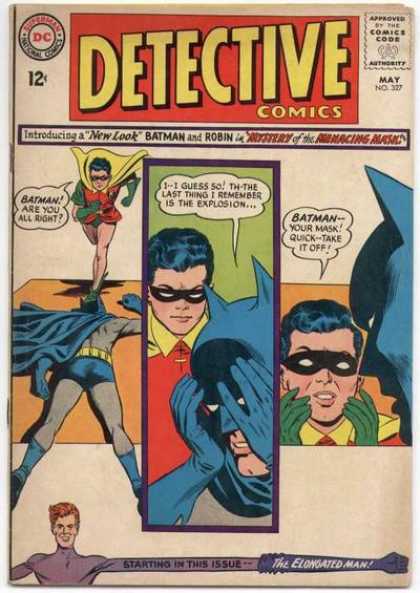How Bad Were Batman’s Sales in the Early 1960s?
 On Saturday I summarized the standard historical picture of Batman comics in the early 1960s: not good. This is widely accepted. For example, at Captain Comics and the Legion of Super(fluous) Heroes, Commander Benson's essay on the "New Look" begins: "By 1963, the Batman titles were dancing on the edge of cancellation."
On Saturday I summarized the standard historical picture of Batman comics in the early 1960s: not good. This is widely accepted. For example, at Captain Comics and the Legion of Super(fluous) Heroes, Commander Benson's essay on the "New Look" begins: "By 1963, the Batman titles were dancing on the edge of cancellation."
But I'm not convinced that DC Comics really thought the Batman character was that unpopular. If that were so, I ask, why did the company keep featuring Batman on the covers of its magazines?
If Batman was no longer popular, why feature him in every issue of World's Finest? The company could have had Superman team up with one of its new superheroes instead. Why give Batman cameo appearances in the Justice League of America stories if he was newsstand poison?
Why not drop Batman from the cover of Detective Comics and move a more popular feature up to the lead? That's what happened in the late 1940s when Tomahawk replaced Robin as the featured character in Star Spangled Comics. Robin continued to have solo adventures, just not as prominently; it took more issues before his stories disappeared altogether.
And if finding a way to save Batman was a dire corporate emergency, why did the DC wait for the 300th issue of Detective Comics featuring Batman to launch the "New Look"? As I prepared this series of essays, I discovered that in a discussion at The Fifth Branch Pat Curley of the Silver Age Comics blog expressed the same doubts. Except he did it using hard data—DC's reported sales numbers:
As I prepared this series of essays, I discovered that in a discussion at The Fifth Branch Pat Curley of the Silver Age Comics blog expressed the same doubts. Except he did it using hard data—DC's reported sales numbers:
If you look at DC’s sales in the early 1960s, while Batman and was slipping relative to the Superman books, they were well ahead of most of DC’s other comics. In 1962, Batman was reportedly the 10th best selling comic, with 410,000 copies per issue sold.Canceling the Batman comics would have been especially drastic if Gerard Jones's Men of Tomorrow is correct about Bob Kane's 1947 contract. Cancellation would have caused all rights in the character to revert to Kane. DC would have given up what was still its second-biggest property forever. I strongly doubt the company would have done that without trying less drastic options.
That’s quite a bit more than JLA or Flash, or Green Lantern, or 20 other mags that DC was publishing at the time. It’s almost three times as many copies as DC was selling of Fox & Crow, a title that continued for years afterward. Unfortunately, DC did not publish circulation figures for many of their major mags in 1963 and 1964 (including Batman).
Batman’s circulation was down in 1962 quite substantially from 1961 (485,000) and 1960 (502,000), which is a bad trend, and one which probably led to [editor Jack] Schiff’s eventual reassignment. But I have a hard time believing that it could have dropped so low in 1963 that DC was seriously considering canceling the feature rather than doing what they did, which was restaffing the editor’s desk.
TOMORROW: So why in 1963 did DC's top brass tell Bob Kane that they were thinking of canceling Batman entirely?
(All images courtesy of Cover Browser.)


No comments:
Post a Comment